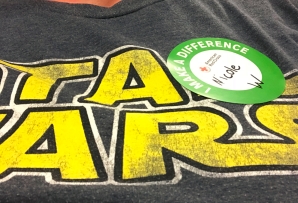For the month of July, author and entrepreneur Jesse Itzler challenged the We Do Hard Stuff group to 35 workouts and to give back to their community.
I use Charity Miles, an app that donated money to charity for every mile you run, walk and bike. But, donating my time and effort locally? That was a head-scratcher.
Then, later in the month, someone put a flyer on our car’s windshield for a Red Cross blood drive at the local extension agency office that’s sponsored by a Girl Scout troop. I brought the flyer into the car and just looked at it. In all of my 42 years of life, I hadn’t once given blood.
When we lived in Texas, my mom regularly gave blood. It may have been for the perk of reduced cost of ambulance rides in case something happened to my dad, but I suspect it was because it was an easy way for her to help people.
It should have been easy for me donate in college, as my campuses seemed to be a frequent target of the Red Cross. But for one reason or another, I never stepped foot into a blood drive to give actually give blood.
I ran my errand, flyer still in the front passenger seat, and looked at it one last time. The blood drive was being held that day and there was just half an hour left. I put the groceries in the house and yelled for one of the kids to come with me, I was going to give blood and needed moral support. In secret, I wanted someone to come so I couldn’t talk myself out of donating blood.
Just in case you’re thinking of giving blood — not everyone can donate. If you recently gave birth or are pregnant, you can’t donate. You can’t donate if you recently got a tattoo or went on a trip to certain parts of the world. You can’t donate if you do drugs or are underweight. If you’re under 18, you have to be at least 16, weigh at least 110 pounds and get parental consent before you can donate.

The best way to do a blood donation is to go through the company or nonprofit that serves your area and set up an appointment. It speeds up the process. As a first time donor, I just showed up, got signed in and received a first-timer’s sticker from the Girl Scouts.
After waiting for a while, I was taken to a enclosed area — as enclosed as you can get with a temporary set-up — and was asked a series of questions. Did I have a kid recently? Did I get a tattoo recently? etc. I also had to give them my driver’s license so they could input my information in a database. Every pint of blood is tracked back to its origin in case something isn’t right. Also, it gets you set up so you can get a donor card which expedites the process next time.
After I was done, I waited for a table to sit on. The skilled Red Cross workers had already done about 70 donations that day. They prep your arm by sanitizing it and checking for a vein. Then, a needle is put in your arm that gathers the blood and sucks in down into a tube leading to the pint container.
![IMG_8113[1]](https://mtnmamaadventures.files.wordpress.com/2018/07/img_81131.jpg?w=201&h=201)
According to one of the workers I talked with, the procedure (except maybe the first part of the needle going into your skin) should be totally painless.
After you’re done, you may get a shirt out of your donation. But you’re there for the snacks and drinks. Donors are suppose to sit in the “canteen” for 15 minutes so workers can make sure you don’t have any side effects from the donation. My helper also had some juice and cookies and posed with the Scouts. He even got a medal for being cool.
While I was there, someone donated blood at the same time I did, but was done after I was. He got off the table and slumped down to the floor. Passing out, having dizzy spells are among the more serious side effects from blood donation. For me, I had a nice sized bruise for a few weeks.
But according to the Red Cross, my one pint of blood saved three lives. A bruise and about a half an hour of my time is a small price to pay. You have to wait six weeks or so between blood donations.
I’m already signed up for the next local blood drive. I’ll be a super donor, as I have very useful blood type. Especially now, with blood donations being down around the country, my blood is even more vital.
If you become a super donor for the Red Cross, they’ll gather one pint of blood and then another pint of just red blood cells. The other things withdrawn with the red blood cells are mixed with saline and get put back into your body. The process takes about 30 minutes longer than the standard donation.
I can’t believe I waited so long to do this. It’s simple and easy. You just have to make the time to do it.
